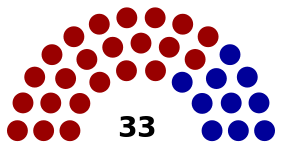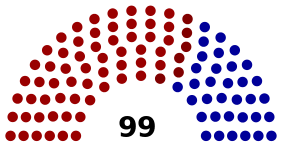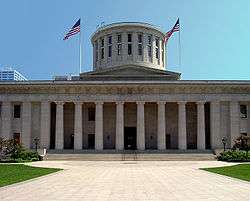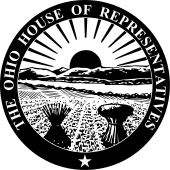Ohio General Assembly
| Ohio General Assembly | |
|---|---|
| 131st Ohio General Assembly | |
 | |
| Type | |
| Type | |
| Houses |
Senate House of Representatives |
| Leadership | |
President of the Senate | |
President Pro Tempore (Senate) | |
Speaker Pro Tempore (House) |
Ron Amstutz Since January 3, 2015 |
| Structure | |
| Seats |
132 voting members: 33 senators 99 representatives |
 | |
Senate political groups |
|
 | |
House political groups |
|
| Authority |
Article II Ohio Constitution |
| Elections | |
Senate last election |
November 4, 2014 (16 seats) |
House last election |
November 4, 2014 (99 seats) |
| Meeting place | |
 | |
|
Ohio Statehouse Columbus, Ohio, United States | |
| Website | |
|
General Assembly Senate House of Representatives | |
The Ohio General Assembly is the state legislature of the U.S. state of Ohio. It consists of the 99-member Ohio House of Representatives and the 33-member Ohio Senate. Both houses of the General Assembly meet at the Ohio Statehouse in Columbus.
Legislative agencies
The Legislative Service Commission is one of several legislative agencies. It serves as a source for legal expertise and staffing and drafts proposed legislation.
History
The General Assembly first convened in Chillicothe, then the Ohio capital, on March 1, 1803.[1]
The second constitution of Ohio, effective in 1851, took away the power of the General Assembly to choose the state's executive officers, granting that right to the voters. A complicated formula apportioned legislators to Ohio counties and the number of seats in the legislative houses varied from year-to-year.
The Ohio Politics Almanac by Michael F. Curtin (Kent State University Press) described apportionment thus:
- "The new [1851] constitution ... contained a complicated formula for apportionment, the so-called "major fraction rule." Under it, the state's population was divided by 100, with the resulting quotient being the ratio of representation in the House of Representatives. Any county with a population equal to at least half the ratio was entitled to one representative; a county with a population of less than half the ratio was grouped with an adjacent county for districting; a county containing a population of at least one and three-fourths the ratio was entitled to two representatives; a county with a population equal to three times the ratio was entitled to three representatives. To determine Senate districts, a similar procedure was followed; the starting point, however was figured by dividing the state's population by 35. The ratios for the House and Senate and the resulting apportionment was determined by a board consisting of the governor, auditor, and secretary of state."
In 1903, the apportionment system was modified by the Hanna amendment, which also gave the governor veto power over the assembly's acts, which could be overridden by a two-thirds vote of both houses. The last state constitutional convention, held in 1912, gave the governor a line-item veto, but reduced the supermajority required for overriding the veto to three-fifths. In 1956, a referendum increased the terms of state senators from two to four years.
The Hanna amendment (which guaranteed each county at least one representative and all members elected at large) guaranteed that rural areas of Ohio would dominate the legislature. Several decisions by the U.S. Supreme Court in the 1960s, however, mandated apportionment proportional to population. Reapportionment was ordered in 1964. Starting with the 1966 election, the number of seats in the two chambers were fixed at their present numbers of 33 and 99.
Republican activists, led by Fred A. Lennon, began pursuing term limits in the 1980s, in 1992, a referendum set term limits of eight consecutive years in office: four consecutive terms in the House or two consecutive terms in the Senate. Years in office are considered consecutive if they are separated by less than four years. A former member of the legislature who had served eight years becomes eligible for election to the legislature after four years out of office.
See also
- Representative history of the Ohio Senate
- Representative history of the Ohio House of Representatives
References
- ↑ Blue, Frederick J. (Autumn 2002). "The Date of Ohio Statehood". Ohio Academy of History Newsletter. Archived from the original on September 11, 2010.
Further reading
- Curtin, Michael F. (1996). The Ohio Politics Almanac. Kent State University Press. ISBN 9780873385404.
- Gold, David M. (2009). Democracy In Session: A History of the Ohio General Assembly. Ohio University Press. ISBN 9780821418444.
- "A Guidebook For Ohio Legislators, 2013-2014" (PDF). Ohio Legislative Service Commission. Retrieved 12 August 2014.
- Little, Thomas H.; Ogle, David B., eds. (2006). The Legislative Branch of State Government: People, Process, and Politics. ABC-CLIO. pp. 369–373. ISBN 9781851097616.
- Scarselli, Gino J.; Steinglass, Steven H. (2011). The Ohio State Constitution. Oxford University Press. ISBN 9780199778720.
External links
Coordinates: 39°57′42″N 82°59′55″W / 39.9616°N 82.9987°W

